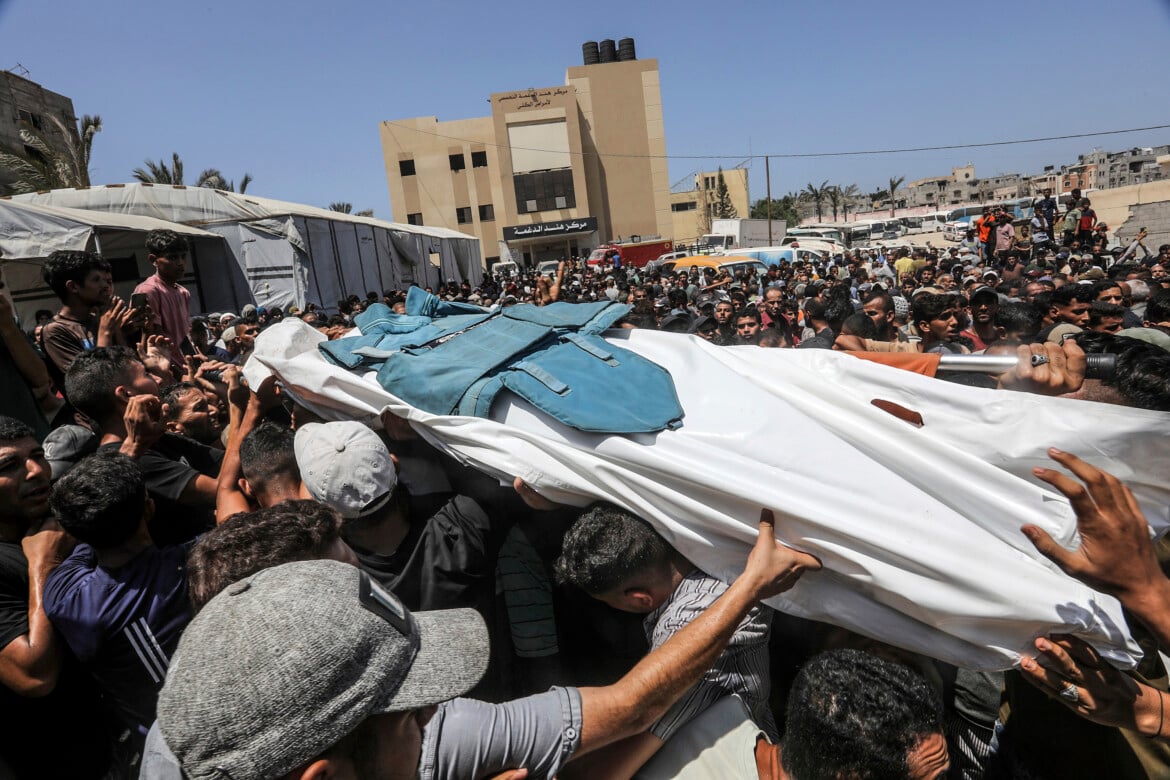Report
The journalists of Gaza: killed, disappeared and tortured
‘Assassination of Truth,’ a report from the Palestinian Center for Human Rights, conducted over 1,000 interviews. ‘We are exhausted, overwhelmed, drained. We are psychologically traumatized.’

“There’s no guarantee we’ll make it to tomorrow. Who will be next? And what will be the next justification?”
Hind Khoudary, a Palestinian journalist, has so many questions and so little time. Her shift begins in 15 minutes, and she has to shoot a report. A contributor to Al Jazeera English and the Anadolu Agency, she has been in the field for over 700 days and is reporting from the Gaza Strip on the presentation of the report Assassination of Truth: The Killing of Journalists During the Genocide in Gaza by the Palestinian Center for Human Rights (PCHR).
The report is about her, her colleagues and her friends, who continue to die at an average rate of 11 per month, according to the Gaza Media Office. On September 8, another was lost: Osama Ahmed Balusha, a journalist targeted and killed while spending time with his family at home. Khoudary is visibly tired, her internet connection unstable.
“We are exhausted, overwhelmed, drained. We are psychologically traumatized.” She is one of the “irreplaceable” voices, ears, and eyes of Gaza, made so by the ban on entry for international press. Without Palestinian journalists, “no one would know what is happening,” Khoudary says.
Being a journalist in Gaza often means taking on other ad hoc roles, like that of a first responder, and doing so with “no protection of any kind under most of our contracts.” Living and working conditions are precarious, and safety equipment is outdated. “The equipment has been in the Gaza Strip for more than ten years; most of it is expired. We asked to receive bulletproof vests and helmets, but the requests were not granted.”
This is another aspect of the control exercised by the Israeli occupation, which targets journalists both in the field and online. “If you check my X account, you will find threats, people cursing at me: ‘we will get you, we will kill you, we will do things to you…’ Very harsh comments.” Khoudary has no guarantee that something won’t happen during her shift. “Every time I stand in front of the camera, I see Anas Al-Sharif, Mohammed Qreiqeh, Hamza Al-Dahdouh, Iman Al-Shanty, I see Maryam Abu Daqqa, Ismail Al-Ghoul – I see them all. That’s why I continue, and so does every single Palestinian.”
Featuring over 1,000 collected testimonies, the report on the targeting of journalists and media institutions in Gaza over the last 23 months was published just as the Israel Defense Forces (IDF) bombed the PCHR’s headquarters in Gaza City, as part of systematic attacks on high-rise buildings. It also comes just days after the U.S. imposed sanctions on PCHR, Al-Haq and Al-Mezan. Once again, the goal is to silence and destroy.
For those who believe in responsibility and human dignity, this won’t be enough to stop the work towards “justice, democracy, and human rights,” says Raji Sourani, founder and director of the PCHR. He has never had any doubts about what is happening, and now he has the evidence gathered in the report. “Journalists were the target of this genocide from day one,” he says.
For Antoine Bernard, director of Reporters Without Borders (RSF), journalists are the guardians of collective memory and Palestinian identity. “To target Palestinian journalists is not just to obstruct the present, but to erase the future,” he says. The numbers are widely known, and unacceptable: over 210 journalists killed since October 2023, including at least 56 cases where RSF believes they were intentionally targeted while on duty. Added to this is the double victimization: journalists who are killed are then labeled as terrorists.
Maryam Abu Daqqa, Moaz Abu Taha, and Hussam Al-Masri were all killed on duty during a live television broadcast from Nasser Hospital in Khan Yunis, in the south of the enclave. And it is in Khan Yunis especially that things are happening that those in power don’t want anyone to see: arbitrary arrests, enforced disappearances of journalists, and documented torture, including beatings, sleep deprivation, and the denial of hygiene, medical care and food. The Committee to Protect Journalists (CPJ) has counted 86 arrests and two disappearances, but as with the killings, establishing an accurate final number is impossible. “The world should bear in mind that such a relentless level of international crimes against journalists in Gaza has raised the threshold of tolerance for crime to unprecedented levels,” Bernard warns.
Originally published at https://ilmanifesto.it/i-giornalisti-palestinesi-a-gaza-uccisi-scomparsi-torturati on 2025-09-09
